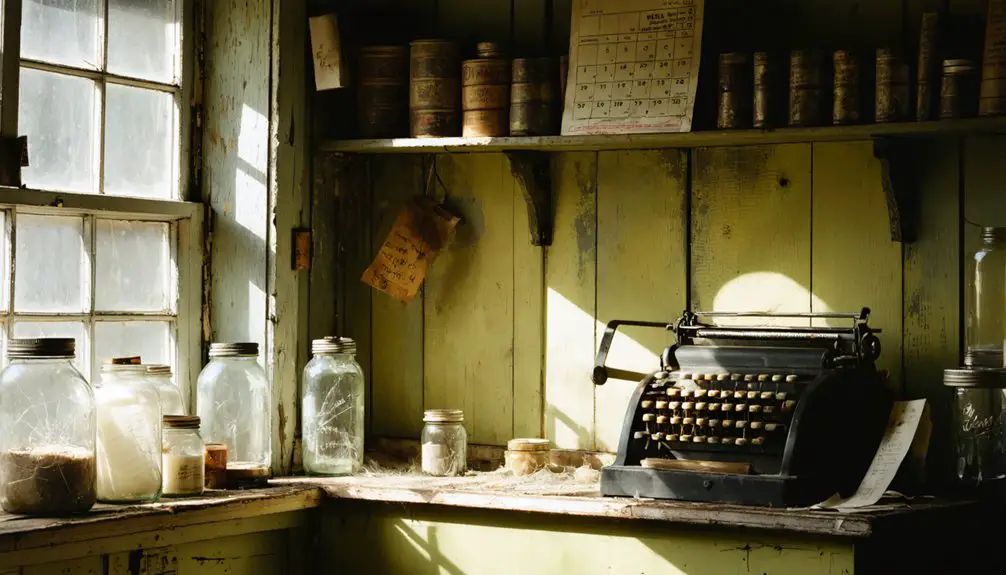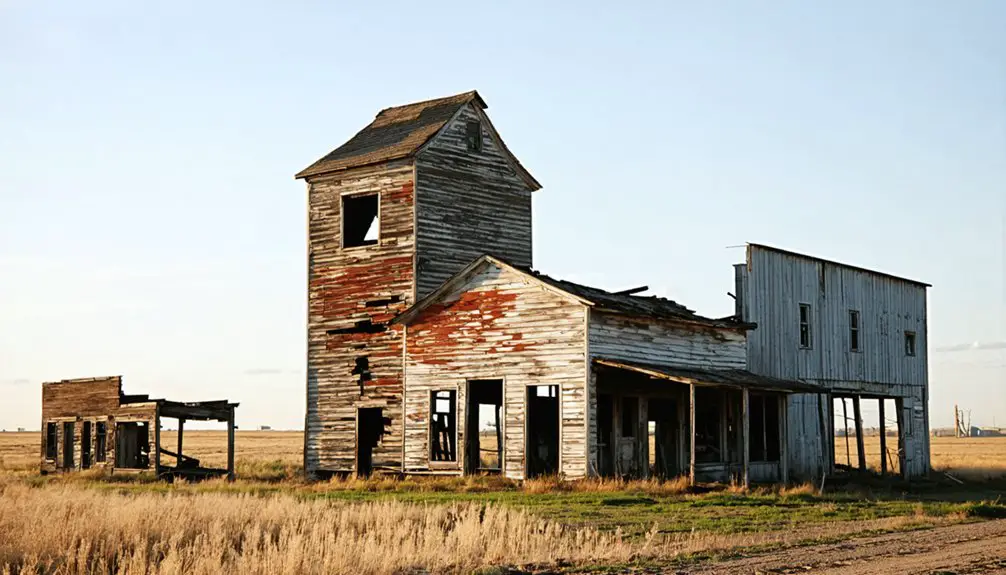You’ll find Camchester nestled in Kansas’s heartland, a former railroad boomtown that thrived during the 1880s limestone quarrying era. The town’s population peaked at 200 residents during its industrial heyday, with a bustling main street of hardware stores, dry goods shops, and a Ford dealership. By 2020, only 47 people remained, leaving behind deteriorating storefronts and grain elevators. The town’s rich legacy of pioneer settlement, mining operations, and railroad heritage holds countless untold stories.
Key Takeaways
- Camchester declined from 250 residents in 1910 to just 47 by 2020, transforming from a bustling railroad town into a ghost town.
- The town’s economy originally thrived on limestone quarrying, railroad operations, and agriculture before its eventual decline.
- Main street features abandoned buildings and deteriorating facades, with visible remains of grain elevators and railroad infrastructure.
- Natural disasters, particularly tornadoes and droughts, contributed significantly to the town’s depopulation and economic downturn.
- Local preservation groups work to protect Camchester’s heritage through clean-up events and historical documentation despite financial limitations.
The Rise and Fall of Camchester
While many Kansas towns emerged during the railroad expansion of the 1880s, Camchester’s story uniquely intertwined with both rail development and limestone quarrying. Like many ghost town sites across Kansas, the town aspired to gain county seat status but ultimately fell short.
Camchester’s origins reflect a rare convergence of Kansas railroad growth and limestone mining, setting it apart from typical 1880s boom towns.
You’ll find that as the railroad acquired substantial tracts for quarry operations, the town flourished, reaching a population of 200 during its industrial peak. The quarries brought regional recognition and sparked vibrant community events that celebrated the town’s cultural heritage. Following the pattern of nearby Home City, Camchester served as a vital shipping hub for agricultural products.
But Camchester’s prosperity wouldn’t last. The decline of rail transportation dealt the first blow, while agricultural mechanization reduced local labor needs.
As larger cities drew residents away and quarries shut down, the town’s liveliness faded. By mid-1900s, the once-bustling community saw sharp population drops, with remaining residents primarily involved in farming or minimal industry operations.
Pioneer Settlement and Early Days
Three distinct Native American tribes – the Kansa, Osage, and Pawnee – inhabited the region that would become Camchester long before European settlers arrived.
These tribes thrived off the land, with the Kansa claiming territory along the Kansas River and the Osage dominating the Arkansas River region by the late 1600s.
When pioneers first ventured into the area, they’d journey by steamboat from St. Louis to Kansas City before striking out on foot.
You’ll find that pioneer resilience was tested immediately by harsh conditions, including devastating droughts and prairie fires.
The early community took shape as settlers staked their claims, built makeshift homes from logs and prairie grass, and established rudimentary boarding houses.
Despite territorial conflicts with pro-slavery Missourians, free-state settlers persisted in building their new home.
The New England Emigrant Aid Company helped organize groups of settlers to reduce travel hardships and establish essential community services.
Many settlers marked their territorial boundaries using notched trees to establish their claims in the region.
Railroad’s Impact on Town Development
As Kansas territory opened for settlement in the 1860s, the arrival of major rail lines transformed Camchester from a modest pioneer outpost into a bustling frontier town.
You’d have witnessed dramatic railroad expansion throughout the region, with track mileage soaring from just 71 miles in 1865 to over 1,200 miles by 1870.
The enhanced transportation accessibility meant you could now ship local goods to distant markets and receive essential supplies year-round. The federal land grants helped stimulate this rapid railroad construction by providing 6,400 acres per mile of track built.
Rail access made Camchester’s land more valuable, attracting new settlers and businesses to the area. The Santa Fe Railroad reached completion to Dodge City by August 1872, further accelerating growth.
The town’s layout adapted around the tracks and depot, while telegraph offices and maintenance facilities soon followed.
These changes brought new employment opportunities and connected you to a wider cultural and economic network beyond the Kansas prairie.
Economic Life and Local Industries
While the railroad brought numerous jobs to Camchester through its freight operations and maintenance facilities, the town’s economic foundation rested primarily on agricultural activities and cattle ranching.
You’d find local farmers cultivating wheat, corn, and oats in the surrounding fields, while ranchers moved substantial cattle herds through the area’s stockyards for shipment by rail. Similar to how residents in Bell Plane earned their living through apple orchards, this agricultural focus defined the local economy. The town eventually declined when technological advancements reduced the need for agricultural labor in the region.
The town’s business district supported these agricultural enterprises through various merchants, including hardware stores, dry goods shops, and a Ford dealership that served the growing motorized farming community.
Railroad Jobs and Growth
During the late 1800s, Camchester’s economy flourished through the rapid expansion of railroad operations in Kansas. You’d find bustling workshops and roundhouses where skilled workers maintained locomotives, while freight crews and engineers managed the constant flow of trains. The town benefited from being part of Kansas’s remarkable achievement of 498 miles of track laid in 1879 alone. Following the example of Junction City, Camchester developed significant repair facilities to support the growing rail network.
Railroad employment transformed the town’s prospects, creating economic opportunities for locals and newcomers alike.
- The railroad division brought steady jobs in track maintenance, locomotive repair, and freight operations.
- Railroad workshops established near town created industrial positions for skilled laborers and mechanics.
- The expansion of rail services required support staff for passenger services, freight coordination, and administrative duties.
These railway jobs didn’t just support workers – they sparked growth in local businesses, housing development, and trade networks that connected Camchester to markets across Kansas and beyond.
Mining and Agricultural Operations
The discovery of lignite coal by Heim Nelson in 1869 transformed Camchester’s economic landscape, leading to the rapid development of over 30 mines throughout the region.
You’d find miners using basic mining techniques, extracting coal from 25-75 foot shafts using buckets and rope, while living in simple dugouts near the mines.
Agricultural practices thrived alongside mining, with family farms producing wheat, corn, and sorghum.
You could see workers shifting between both industries seasonally, adapting to market demands.
Local businesses served both sectors, with blacksmiths crafting tools for mines and farming equipment, while general stores and boarding houses supported the workforce.
Though mining profits initially drove the economy, it’s the farming that helped sustain Camchester during mining downturns, creating a complex economic web between these essential industries.
Local Business Development
As Camchester evolved from a mining outpost into a thriving commercial center, you’d find a bustling main street lined with essential businesses serving both local residents and travelers.
Business partnerships flourished as merchants established retail operations that reflected the town’s growth, from blacksmith shops and general stores to specialized hardware and drug stores.
- You could conduct financial transactions at the local bank, which processed impressive monthly deposits of $10,000, or handle your postal needs at the money order office.
- The retail evolution brought diverse shopping options, with multiple general stores stocking essentials for the growing population.
- For travelers passing through on the railroad, you’d find comfortable lodging at the hotel, entertainment at the saloons, and dining options along main street’s beautiful thoroughfare.
Natural Disasters and Environmental Challenges
Camchester’s location in Tornado Alley meant you’d frequently find the town battered by devastating storms, with multiple tornadoes striking the settlement throughout its inhabited years.
You’ll see evidence of this destructive weather pattern in the town’s historical records, which document how recurring twisters damaged essential infrastructure, including the railroad connections that once served as Camchester’s economic lifeline.
The region’s susceptibility to drought further complicated life for Camchester’s residents, as periods of minimal rainfall stressed local agricultural operations and accelerated the town’s eventual decline.
Devastating Tornadoes Strike Town
Like many settlements across the Kansas plains, Camchester faced nature’s wrath through devastating tornado strikes that ultimately contributed to its demise.
The town’s tornado preparedness and community resilience were put to the ultimate test as violent twisters, often spanning up to two miles wide, tore through the region with wind speeds exceeding 200 mph.
- Massive air pressure drops of up to 100 mbar occurred within seconds, leveling buildings and stripping trees bare.
- Local warning systems occasionally failed due to lightning damage, leaving residents without advance notice.
- The combination of widespread structural destruction and socioeconomic challenges made recovery impossible.
You’ll find that Camchester’s fate mirrors other plains communities like Manchester, South Dakota, where total destruction led to permanent abandonment and ghost town status.
Today, only memories and monuments remain to tell the tale.
Drought’s Impact on Agriculture
Beyond the destructive tornadoes that leveled buildings, persistent drought conditions brought additional hardship to Camchester’s agricultural community.
You’d have seen farmers struggling with soil moisture management as their fields suffered from the region’s volatile weather patterns. Despite some rainfall improvements in southern Kansas, moderate to severe drought gripped the northern areas throughout 2025, devastating crop prospects across Camchester’s farmlands.
Your neighbors would’ve witnessed the harsh reality of drought resilience strategies failing as topsoil moisture levels dropped to critical levels – 35% short or very short.
While some areas managed to bounce back, with corn yields reaching 138.7 bushels per acre, the combination of heat waves and reduced soil moisture ultimately proved too challenging for many of Camchester’s agricultural operations to sustain.
Community Life and Social Fabric

The social fabric of Manchester, Kansas unraveled steadily between 1910 and 2020, as its population dwindled from 250 residents to just 47.
You’d have found a tight-knit community where life revolved around the railroad station, churches, and general stores. These places weren’t just businesses – they were essential hubs for community gatherings where neighbors connected and shared news.
- Train schedules shaped daily social rhythms, with residents gathering to greet arrivals and send off departures.
- Agricultural cycles brought people together for seasonal celebrations and mutual support.
- Schools served as social anchors until declining enrollment forced consolidation with nearby towns.
As younger generations moved away and transportation patterns changed, you’d see increasing social isolation among remaining residents, though they maintained strong bonds with each other.
Structural Legacy and Remaining Buildings
Standing as weathered sentinels of a bygone era, Camchester’s remaining structures tell stories of its agricultural and railroad heritage through their deteriorating facades.
You’ll find abandoned buildings scattered along the main street, their wooden frames and tin roofs succumbing to time’s relentless march. The architectural features reveal the town’s once-bustling character – stone and brick elements stand partially intact, while broken windows and exposed support beams mark the decay of former homes and businesses.
Walking through Camchester today, you’ll discover the skeletal remains of grain elevators and railroad infrastructure that once drove the local economy.
Old street signs peek through overgrown vegetation, marking roads that have all but disappeared. While most structures continue their slow surrender to nature, they preserve valuable clues about life in this Kansas prairie town.
Notable Residents and Their Stories

While Camchester’s empty buildings stand as silent witnesses today, the town’s history comes alive through the stories of its notable residents who shaped its destiny from the 1870s onward. Notable families, including railroad workers, quarry operators, and merchants, built the town’s economic foundation.
You’ll find their legacies woven throughout early Kansas frontier culture, from the general store owners who served as postmasters to the clergy who maintained social bonds.
- Individual legacies emerge from tales of residents who relocated entire homes during economic shifts.
- Multi-generational families preserved community traditions through local leadership roles.
- Railroad workers and quarry laborers sustained the town’s significance, with many staying on even after operations ceased.
These resilient pioneers’ stories echo through census records and oral histories, painting a portrait of determination and adaptability.
Preservation Efforts and Historical Documentation
As memories of Camchester’s early residents fade with time, dedicated preservation groups and local historians have mobilized to protect what remains of this Kansas ghost town’s heritage.
You’ll find community involvement through organized clean-up days and preservation events, where volunteers work to stabilize the remaining structures against further decay.
Local historical preservation efforts include collecting oral histories from former residents, gathering photographs, and preserving important documents like post office records.
Through photographs, documents, and living memories, local historians piece together the story of Camchester’s bygone community.
While financial constraints have limited large-scale restoration projects, passionate community members maintain informal signage and town markers to keep Camchester’s identity alive.
Some artifacts and smaller structures have found new homes in nearby museums, ensuring these pieces of history won’t be lost to weathering or vandalism.
Documentation continues through academic research and online heritage platforms.
Frequently Asked Questions
Are There Any Paranormal Activities Reported in Abandoned Camchester Buildings?
You won’t find documented ghost sightings in Camchester’s buildings. While haunted locations exist throughout Kansas, there’s no verified paranormal evidence from this ghost town’s abandoned structures or surrounding areas.
What Traditional Festivals or Celebrations Were Unique to Camchester?
While you won’t find unique festivals documented, you’d likely have experienced typical Pioneer Days celebrations and harvest festivals similar to other Kansas railroad towns during Camchester’s prime in the late 1800s.
Did Any Famous Outlaws or Criminals Pass Through Camchester?
You won’t find any outlaw legends or criminal hideouts linked to Camchester. Unlike other Kansas towns with famous desperados, historical records don’t show any notorious outlaws passing through this quarry town.
What Native American Tribes Originally Inhabited the Camchester Area?
As the crow flies, tribal history shows the Kanza (Kaw) and Osage peoples were the primary inhabitants of your area, with cultural significance stretching back generations before forced relocation.
Were There Any Significant Archaeological Discoveries Made in Camchester?
You won’t find major archaeological findings in Camchester itself. While the region shows evidence of ancient tools and ceramics, no formal excavation techniques have revealed significant discoveries within the town’s boundaries.
References
- https://www.youtube.com/watch?v=iB5rHT14eVI
- https://theactiveage.com/these-kansas-towns-didnt-stand-a-ghost-of-chance/
- https://freepages.rootsweb.com/~gtusa/history/usa/ks.htm
- https://legendsofkansas.com/kansas-ghost-town-list/
- https://www.youtube.com/watch?v=ATG_SISxd3o
- https://www.lostamericana.com/manchester-kansas-some-places-you-can-never-go-back-to/
- https://en.wikipedia.org/wiki/Manchester
- https://www.kspatriot.org/index.php/articles/13-kansas-people/439-the-coming-of-the-settlers.html
- https://legendsofkansas.com/kansas-settlers/
- https://en.wikipedia.org/wiki/History_of_Kansas



